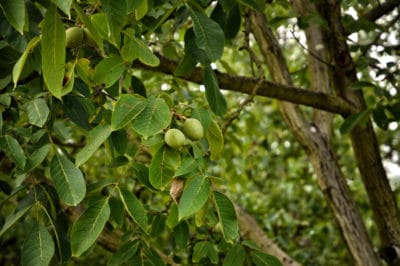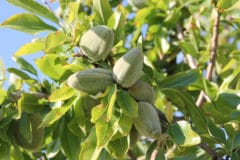How are English walnuts different from black walnuts?
From a grower’s standpoint, English walnuts are more desirable than black walnuts for two reasons:
- English walnuts’ thin, easy-to-crack shells make them much more marketable than black walnuts.
- The trees begin bearing nuts in as little as four years. Black walnut trees need eight to 10 years to produce a harvest.
Where do English walnut trees grow?
Wild English walnut trees grow in USDA plant hardiness zones 3 through 7. Commercial cultivars, however, are adapted to the climate of California’s Central Valley (hardiness zone 9a). Nearly all English walnuts grown in the United States come from there.
Do they have other climate requirements?
Depending on cultivar, English walnuts require 300 to 1500 chilling hours with temperatures between 33° and 45°F (0.55° and 7.2°C) each winter.
Why do they need chilling hours?
Chilling hours stimulate flowering. Without enough of them, the trees won’t produce. They’ll still make fine shade trees, but don’t expect a walnut harvest.
What cultivars need the fewest chilling hours?
English walnut cultivars with low chilling hour requirements include:
- ‘Placentia,’ the best choice for very mild winters. 300 chilling hours.
- ‘Pedro,’ a dwarf cultivar ideal for small yards. 400 chilling hours.
- ‘Serr,’ tolerant of poor soils and hot summers. 600 chilling hours.
How long of a growing season do they need?
To grow walnuts, you should have a frost-free growing season of 140 to 170 days. The longer, the better.
How much heat can they take?
If your summer temperatures regularly top 100°F (38°C), the trees’ nuts will be smaller than normal. The damage escalates above 107°F (41.6°C).
Do all English walnut trees need a cross pollinator?
Not the many self-fertile ones. They can set nuts without having a compatible cross-pollinator nearby. Good choices include ‘Chandler,’ ‘Hartley,’ ‘Franquette’ and ‘Ambassador Carpathian.’
What kind of soil do they need?
English walnuts sink their taproots at least 10 feet deep. They grow best in loose, sandy loam. Tilling the planting site’s upper 27 inches helps the roots establish quickly.
What about sun and water?
To flourish, they require six or more hours of daily sun and 50 or more inches of annual rainfall. The heaviest harvests occur where half the rain falls during the summer. During drought, water them slowly and deeply once a week so the taproots get a drink.
How much fertilizing do they need?
Here’s how to fertilize English walnuts:
- After planting, top dress around the trees with 1 inch of organic compost.
- Starting the following year, spread 30 pounds (10 liters) of the compost evenly around their bases each spring. It supplies enough nitrogen for the year.
It doesn’t get much easier than that!












